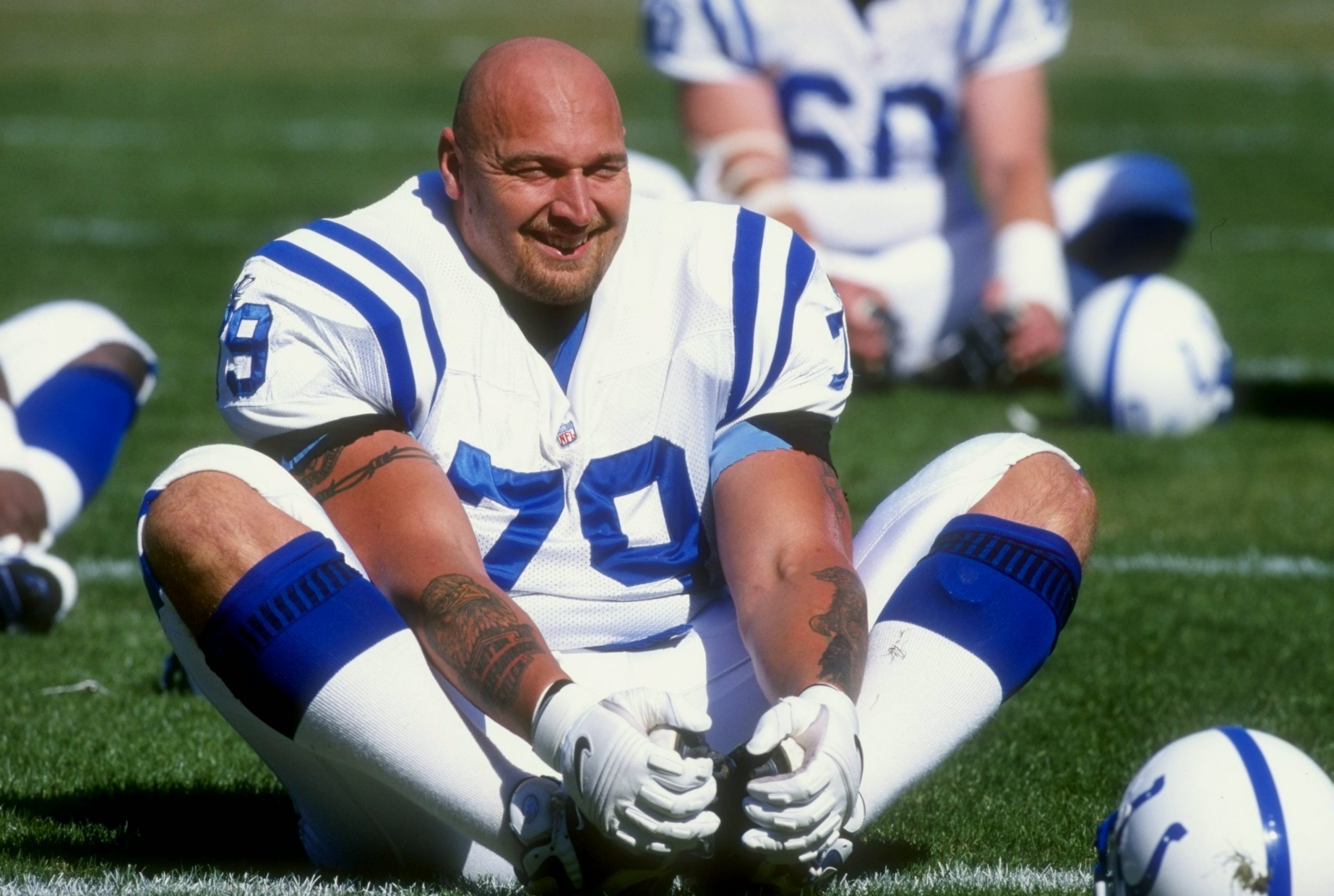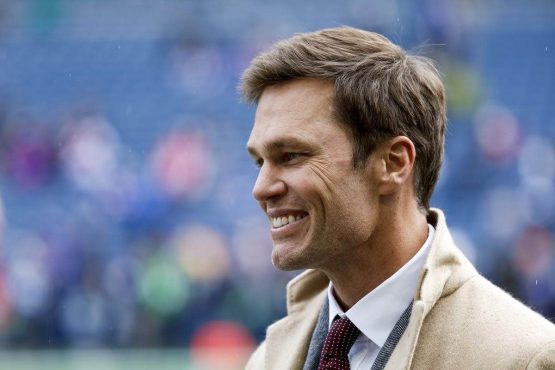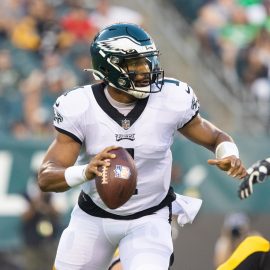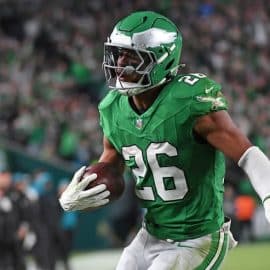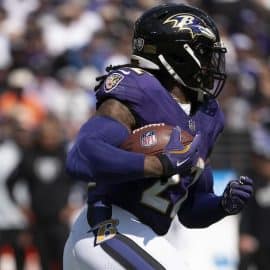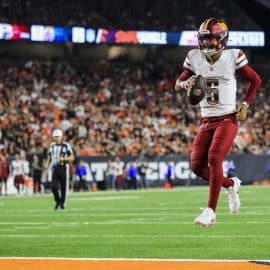The word “bust” flies around in NFL circles this time of year. With the NFL draft right around the corner, pundits tend to look back at the biggest draft busts in NFL history.
But is the word “bust” used too freely? Some players labeled as busts carry that with them after their careers and can’t be mentioned in a sentence without that word.
Some players who are termed “busts” don’t deserve it. Some players save themselves from becoming busts. Others were busts, but there’s more to the story of their careers than that one word.
Each of the following players fall into one of those categories.
Tony Mandarich
Make no mistake, Tony Mandarich deserves not only a bust label but a bust tattoo among the many already on his body.
The Michigan State offensive tackle was featured shirtless on the cover of Sports Illustrated before he was drafted. His jacked physique prompted the headline “The Incredible Bulk” and he was declared “the best offensive line prospect ever.”
Three years later, Mandarich again made the SI cover, but this time the headline screamed “The Incredible Bust.”
Although Mandarich denied it at the time, some of the 320 pounds on his 6’6″ frame were gained with the help of steroids. He stopped using them before the NFL scouting combine for fear of getting caught, and then became addicted to painkillers.
The Packers drafted Mandarich second overall. He was the only one of the top five draft picks that year who didn’t make the Hall of Fame. Troy Aikman went No. 1. Barry Sanders was drafted third. Derrick Thomas was drafted fourth and Deion Sanders was chosen at No. 5.
Mandarich, meanwhile, held out of training camp in his rookie year and didn’t start a game that season. His career in Green Bay lasted just three years before he was out of football and sank deeper into addiction.
He finally checked into rehab in 1995 and was back in the NFL at age 30 in 1996. He was a serviceable right tackle and right guard for three years with the Colts.
Overall, Mandarich’s career was a huge disappointment, but there’s something to be said for his comeback even if it was an unspectacular one. It’s a long road from taking “fifty, 60, 70 painkillers a day” back to the NFL.
Dan Wilkinson
History repeated itself five years after Tony Mandarich adorned the Sports Illustrated cover.
In 1994, it was Dan Wilkinson on the cover. Unlike Mandarich, he wore a shirt because the defensive lineman’s physique wasn’t as flattering. But “Big Daddy” Wilkinson was drafted even higher than Mandarich. He went No. 1 and didn’t live up to the hype.
In this case, the bust designation isn’t entirely fair.
The Bengals drafted Wilkinson and he had 25 sacks in four seasons. He was good enough to be traded to the Redskins for a first- and a third-round draft pick in 1998 and he had 23 sacks in his first four seasons there before his skills started to decline. He refused to take a pay cut in 2003 and spent three years with the Lions before finishing his career with the Dolphins in 2006.
Wilkinson was durable. He started all but 10 games in the first 11 years of his career, and his 54.5 career sacks matched the career total of former Steeler Greg Lloyd.
Perhaps if Wilkinson was a sixth-round pick like Lloyd, he wouldn’t be stamped as a bust.
Mike Mamula
Mike Mamula has been the poster boy for the combine tease who turned out to be a bust.
Former NFL defensive lineman Booger McFarland even dropped Mamula’s name on ESPN, via The Big Lead, in talking about Myles Garrett. This year’s consensus No. 1 overall pick found that so insulting that he refused to be interviewed by McFarland.
Just like Garrett would 22 years later, Mamula lit up the combine and the Eagles drafted him after trading up from No. 12 to No. 7 in 1995.
It’s not like Mamula needed to put himself on the map with his combine performance, however. The defensive lineman had 29 sacks in his last two years at Boston College, according to Pro Football Talk.
Did the Eagles make a mistake drafting Mamula? Yes, but only because the No. 12 pick the Buccaneers received from the Eagles was used on Warren Sapp.
Unlike Sapp, Mamula was no Hall of Famer. But he did have 31.5 career sacks in five seasons, including eight in 1996. He also forced three fumbles that year, returning one for a touchdown. Mamula missed the 1998 season with a knee injury, but came back in 1999 with a career-high 8.5 sacks and a pick-six that season. Mamula suffered more injuries in 2000 and retired at age 27.
While Mamula didn’t live up to his draft billing, it was injuries and not performance that shortened his career.
Mark Barron
The Buccaneers drafted Alabama safety Mark Barron with the seventh pick in the 2012 draft.
The Panthers drafted linebacker Luke Kuechly two picks later.
Unlike 17 years earlier, this time the Bucs were the ones who made the wrong decision.
Kuechly is a three-time All-Pro and was the centerpiece of a defense that helped the Panthers reach Super Bowl 50.
Barron is no longer a Buccaneer.
He had three interceptions and two sacks in his first two and a half years, and the Bucs traded him to the Rams halfway through the 2014 season for fourth-round and sixth-round draft picks.
The Bucs are reminded twice a year when they face the Panthers that Barron is no Kuechly.
But, in a way, he is.
Barron moved to linebacker with the Rams. In 2015, he forced three fumbles and led the Rams with 76 tackles. The Rams re-signed him to five-year, $45 million contract before the 2016 season and he had 90 tackles, two interceptions and eight passes defended last season.
The Buccaneers still would have been better off drafting Kuechly, but if Barron keeps up the good work he won’t go down as a bust.
Alex Smith
Alex Smith has made two Pro Bowls in the last four years. He’s 60-26 as a starter since 2011 and he’s thrown only 38 interceptions during that time. That’s less than both Russell Wilson and Aaron Rodgers.
There was a time, however, when Smith was considered a bust.
The 49ers drafted Smith first overall in 2005 while Rodgers famously waited until the Packers took him at No. 24. Both quarterbacks turned out to be late bloomers.
Smith threw one touchdown pass and 11 interceptions in his rookie season and went 19-31 as a starter in his first six years. His breakout season came in 2011, when he threw 17 touchdown passes and five interceptions and the 49ers went 13-3. Smith had a 104.5 passer rating in nine starts in 2012, but suffered a concussion and lost his starting job to Colin Kaepernick. The 49ers went to the Super Bowl, and that was that. The 49ers traded Smith to the Chiefs for draft picks.
Since then, Smith has thrown single-digit interceptions in six straight seasons and has taken the Chiefs to the playoffs in three of the last four years. Kaepernick, meanwhile, is looking for a job.
Eric Fisher
Alex Smith’s blind-side protector also was a top overall pick and also was developing into a bust at one point in his career.
Eric Fisher started 13 games at right tackle in 2013, his rookie season. He moved to left tackle and started all 16 games there in 2014, but his low point came in 2015 when he temporarily lost the left tackle job. He improved enough for the Chiefs to sign him to a four-year, $48 million contract extension before the 2016 season.
That’s not bust money.
Although Fisher is still a better run blocker than pass blocker, Smith was sacked 28 times last season. That’s the best protection he’s had since coming to Kansas City.
Fisher deserves at least a little credit for that. The bust whispers surrounding him haven’t completely gone away, but he’s hanging in there.
Aundray Bruce
Aundray Bruce is remembered as a No. 1 pick who fell short of expectations.
That’s true, but if Bruce were drafted in any other year, history might be treating him better.
There were no prospects in 1988 who projected as can’t-miss No. 1 picks, and Bruce was chosen No. 1 almost by default.
“Another year in the draft, and he’s in the middle of the first round. He’s not No. 1,” Don Banks, then of Sports Illustrated, told the NFL Network.
It turned out that three Hall of Famers were chosen in the first round and two more in the second. Bruce, drafted by the Falcons, wasn’t one of them. But he did last 11 years in the NFL and recorded 32 career sacks, including six in each of his first two seasons.
The linebacker added four sacks in his third year and had three interceptions and eight forced fumbles in his four years in Atlanta, but he never fit the defensive scheme. Head coach Jerry Glanville, who took over in 1990, tried to make him into a tight end but all Bruce could accomplish there was one career catch for 11 yards.
The Falcons let Bruce leave as a Plan B free agent. Plan B was a precursor to true free agency in which teams were allowed to protect 37 players, so the only free agents were fringe players. Bruce signed with the Raiders and started just seven games in seven years, but he had half of his 32 career sacks in the silver and black because he was used as a situational pass rusher.
A No. 1 pick needs to have every-down impact, but if Bruce was chosen later in the first round, he might have a more sympathetic place in history.
Chris Long
Like Aundray Bruce 20 years earlier, Chris Long is a top-two pick who has become a situational pass rusher.
Long has had a better career than Bruce. He has 58.5 career sacks, but he’s never made a Pro Bowl and there’s still a sense of unfulfilled potential.
The Rams drafted Long with the No. 2 pick in 2008. His rise was slow and steady. After 17.5 sacks in his first three seasons, Long had a breakout year in 2011 with 13 sacks. He followed that up with 11 the next season and 8.5 in 2013. But he was hobbled by injuries in 2014 and 2015 and had just four sacks combined in those two seasons before the Rams released him.
The Patriots picked up Long last year and he had four sacks, including a strip sack that ended the Jets’ hopes for a game-winning drive in a 22-17 Patriots win in Week 12.
The 32-year-old Long signed with the Eagles, which will be his third team in three years. No. 2 draft picks aren’t supposed to become journeymen, but not very many draft busts have a Super Bowl ring to show for their career.
Mark Ingram
Mark Ingram won the Heisman Trophy in 2009 and the Saints chose him with the 28th pick in the draft.
Ingram averaged less than 500 yards in his first three seasons, and when his name was mentioned the term “bust” often followed.
Ingram basically split carries with Pierre Thomas and had fewer rushing yards in his first three seasons than another Alabama running back, Trent Richardson, had in his first three seasons.
Things changed in 2014 when Thomas turned 30 and Ingram hit 25. Ingram ran for a career-high 964 yards and nine touchdowns, earning a Pro Bowl berth. He followed that with 769 yards in 2015 and turned in his first 1,000-yard season in 2016. Despite losing 133 carries to Tim Hightower, Ingram ran for 1,043 yards on 205 carries with six touchdowns. He’s also contributed more as a pass catcher in the last two years with 50 receptions in 2015 and 46 last season.
Hightower is now a 49er, so Ingram doesn’t have to share the backfield.
Darrius Heyward-Bey
Darrius Heyward-Bey has had an itinerant NFL career, and he’s had to carry “bust” baggage with him along the way.
Heyward-Bey’s 64-catch, 975-yard season with the Raiders in 2011 has been an outlier in his career. He hasn’t caught more than 41 passes in any other season.
It should be the Raiders, not Heyward-Bey, who are looked down upon in history. They fell for his 4.3 time at the 2009 combine and drafted him seventh overall. That was too high, and after four years in Oakland Heyward-Bey spent a year with the Colts and then went to the Steelers.
Heyward-Bey has caught just 29 passes in his three seasons with the Steelers, but in each of the last two seasons he’s caught two of those passes for touchdowns and he also ran for a 60-yard touchdown on a reverse last season.
Now 30, Heyward-Bey’s primary role with the Steelers remains on special teams. Not very many draft busts are still in the NFL at age 30.
Add The Sports Daily to your Google News Feed!
